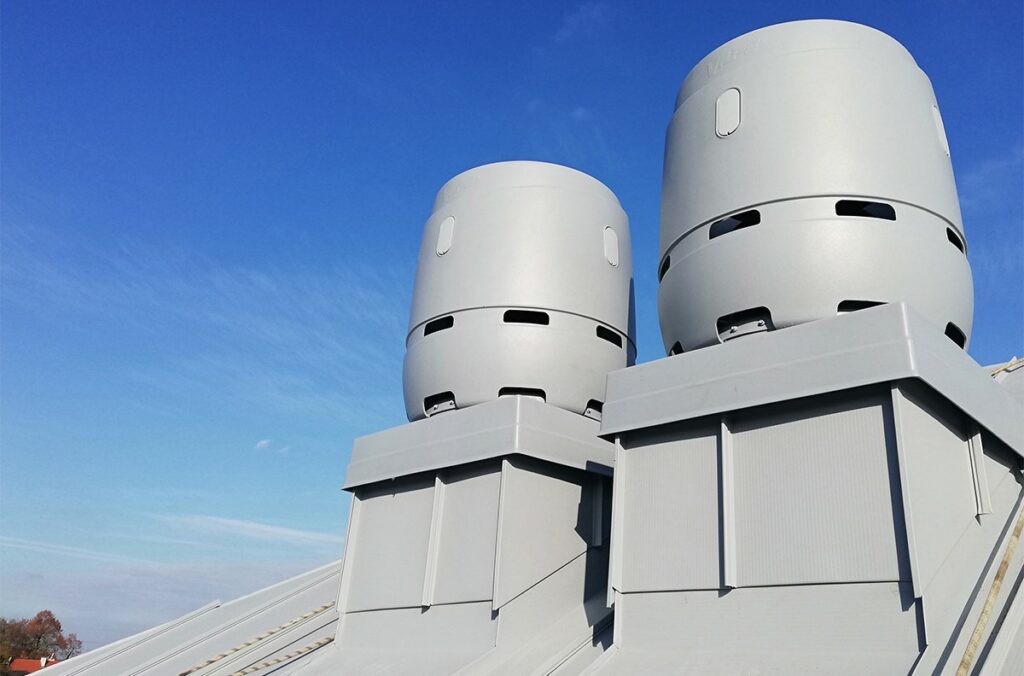What does ‘pressure drop’ mean, and what is its significance in HVAC design?

Descriptions of many of VILPE’s products, such as FLOW exhaust pipes and hoods, often use the phrase ‘low pressure drop’, which is associated with saving energy. But what does ‘pressure drop’ actually mean in practice?
“’Pressure drop’ means the difference in pressure between two points in a network which carries gas or liquid. For example, a supply air vent or an exhaust air vent in a ventilation system causes a pressure drop, because air pressure is higher on one side of the vent than it is on the other. In the case of a supply air vent, air pressure is higher before it enters the room being supplied than it is inside the room. This is because the vent causes a pressure drop when the airflow hits it; the airflow then slows down a little,” says Martin Granö, one of VILPE’s product engineers.
All ventilation terminals have their own pressure drop table, which shows the pressure drop at different airflows. The pressure drop at most terminals can also be adjusted to get the right amount of air into a room; if the airflow at a terminal cannot be adjusted directly, a damper installed in the duct itself can be used instead.
Pressure drops are usually measured and adjusted in connection with the equilibration of a ventilation system, so that the airflows specified by the ventilation designer can be implemented in each room. Pressure drops are measured through terminals and/or dampers, and can be adjusted to achieve the desired airflow.
The balancing of a ventilation system is usually carried out before a building is commissioned, or in connection with the cleaning of an already existing ventilation system.
The article continues after the picture.

What exactly causes a pressure drop?
“In a ventilation duct system, pressure drops are caused by, among other things, the duct itself, duct curves, terminals and dampers. Some components in ventilation units, such as radiators and filters, can also cause pressure drops. A ventilation designer is usually assisted by a design program, one which can calculate the effects of all the pressure drops across an entire ventilation duct network. Based on this, we know how efficient the ventilation unit’s fan needs to be,” says Granö.
A ventilation unit’s fan adds pressure to a ventilation duct system, causing air to start moving in order to equalize the overall pressure.A supply air fan, for example, increases the pressure outside of a room which needs to be supplied with air: this makes the higher-pressure air move towards the lower-pressure air within the room. The fan also creates a vacuum between the space inside it and the outside air, which is what causes the outside air to enter the duct in the first place. The pressure increase created by the ventilation unit must be higher than the pressure drop created by its vent in order for air to enter the room.
A low pressure drop saves energy and money
So why pay attention to pressure drops? Martin Granö says that the lower its overall pressure drop, the more cost-effective a ventilation system is. A ventilation terminal with a low overall pressure drop reduces the energy consumption of a ventilation unit, and both nature and one’s wallet benefit from the energy saved.
“A ventilation system’s overall pressure drop can be affected by the design of the products within it—such as supply air fans–which increase or decrease air pressure. We strive to design products which create the lowest possible pressure drop in our ventilation terminals,” says Granö.
For example, VILPE FLOW 315, 400, 500 & 630S exhaust vents are designed to be energy efficient, so they all have a low pressure drop. The unit used to measure pressure drop is the Pascal (Pa), which can be found using a differential pressure gauge. Granö says that the optimum range of pressure drop for exhaust ventilation pipes is about 10–60 Pa, and for exhaust and supply air vents about 20–50 Pa. According to Granö’s calculations, for example, the total pressure drop of the VILPE 315S FLOW exhaust vent at 0.7 m3 / s air flow is 50 Pa, while with a corresponding reference product it is 168 Pa.
“Usually, pressure drop also correlates with sound: if there is a high pressure drop, more noise will be heard from the ventilation equipment. Conversely, the equipment is quieter when the pressure drop is low,” says Granö.
